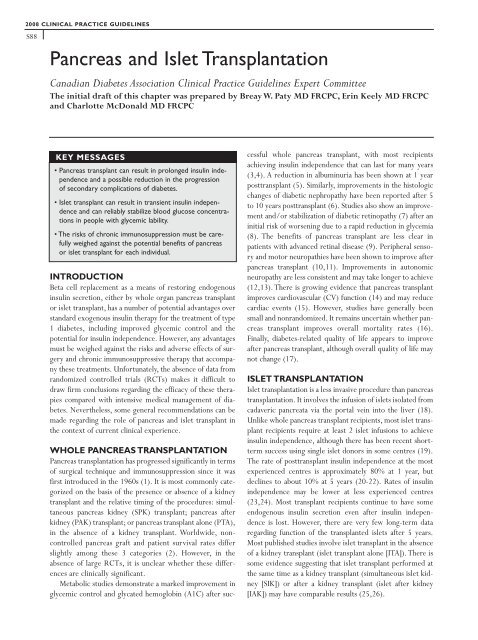2008 Clinical Practice Guidelines - Canadian Diabetes Association
2008 Clinical Practice Guidelines - Canadian Diabetes Association
2008 Clinical Practice Guidelines - Canadian Diabetes Association
Create successful ePaper yourself
Turn your PDF publications into a flip-book with our unique Google optimized e-Paper software.
<strong>2008</strong> CLINICAL PRACTICE GUIDELINES<br />
S88<br />
Pancreas and Islet Transplantation<br />
<strong>Canadian</strong> <strong>Diabetes</strong> <strong>Association</strong> <strong>Clinical</strong> <strong>Practice</strong> <strong>Guidelines</strong> Expert Committee<br />
The initial draft of this chapter was prepared by Breay W. Paty MD FRCPC, Erin Keely MD FRCPC<br />
and Charlotte McDonald MD FRCPC<br />
KEY MESSAGES<br />
• Pancreas transplant can result in prolonged insulin independence<br />
and a possible reduction in the progression<br />
of secondary complications of diabetes.<br />
• Islet transplant can result in transient insulin independence<br />
and can reliably stabilize blood glucose concentrations<br />
in people with glycemic lability.<br />
• The risks of chronic immunosuppression must be carefully<br />
weighed against the potential benefits of pancreas<br />
or islet transplant for each individual.<br />
INTRODUCTION<br />
Beta cell replacement as a means of restoring endogenous<br />
insulin secretion, either by whole organ pancreas transplant<br />
or islet transplant, has a number of potential advantages over<br />
standard exogenous insulin therapy for the treatment of type<br />
1 diabetes, including improved glycemic control and the<br />
potential for insulin independence. However, any advantages<br />
must be weighed against the risks and adverse effects of surgery<br />
and chronic immunosuppressive therapy that accompany<br />
these treatments. Unfortunately, the absence of data from<br />
randomized controlled trials (RCTs) makes it difficult to<br />
draw firm conclusions regarding the efficacy of these therapies<br />
compared with intensive medical management of diabetes.<br />
Nevertheless, some general recommendations can be<br />
made regarding the role of pancreas and islet transplant in<br />
the context of current clinical experience.<br />
WHOLE PANCREAS TRANSPLANTATION<br />
Pancreas transplantation has progressed significantly in terms<br />
of surgical technique and immunosuppression since it was<br />
first introduced in the 1960s (1). It is most commonly categorized<br />
on the basis of the presence or absence of a kidney<br />
transplant and the relative timing of the procedures: simultaneous<br />
pancreas kidney (SPK) transplant; pancreas after<br />
kidney (PAK) transplant; or pancreas transplant alone (PTA),<br />
in the absence of a kidney transplant. Worldwide, noncontrolled<br />
pancreas graft and patient survival rates differ<br />
slightly among these 3 categories (2). However, in the<br />
absence of large RCTs, it is unclear whether these differences<br />
are clinically significant.<br />
Metabolic studies demonstrate a marked improvement in<br />
glycemic control and glycated hemoglobin (A1C) after suc-<br />
cessful whole pancreas transplant, with most recipients<br />
achieving insulin independence that can last for many years<br />
(3,4). A reduction in albuminuria has been shown at 1 year<br />
posttransplant (5). Similarly, improvements in the histologic<br />
changes of diabetic nephropathy have been reported after 5<br />
to 10 years posttransplant (6). Studies also show an improvement<br />
and/or stabilization of diabetic retinopathy (7) after an<br />
initial risk of worsening due to a rapid reduction in glycemia<br />
(8). The benefits of pancreas transplant are less clear in<br />
patients with advanced retinal disease (9). Peripheral sensory<br />
and motor neuropathies have been shown to improve after<br />
pancreas transplant (10,11). Improvements in autonomic<br />
neuropathy are less consistent and may take longer to achieve<br />
(12,13). There is growing evidence that pancreas transplant<br />
improves cardiovascular (CV) function (14) and may reduce<br />
cardiac events (15). However, studies have generally been<br />
small and nonrandomized. It remains uncertain whether pancreas<br />
transplant improves overall mortality rates (16).<br />
Finally, diabetes-related quality of life appears to improve<br />
after pancreas transplant, although overall quality of life may<br />
not change (17).<br />
ISLET TRANSPLANTATION<br />
Islet transplantation is a less invasive procedure than pancreas<br />
transplantation. It involves the infusion of islets isolated from<br />
cadaveric pancreata via the portal vein into the liver (18).<br />
Unlike whole pancreas transplant recipients, most islet transplant<br />
recipients require at least 2 islet infusions to achieve<br />
insulin independence, although there has been recent shortterm<br />
success using single islet donors in some centres (19).<br />
The rate of posttransplant insulin independence at the most<br />
experienced centres is approximately 80% at 1 year, but<br />
declines to about 10% at 5 years (20-22). Rates of insulin<br />
independence may be lower at less experienced centres<br />
(23,24). Most transplant recipients continue to have some<br />
endogenous insulin secretion even after insulin independence<br />
is lost. However, there are very few long-term data<br />
regarding function of the transplanted islets after 5 years.<br />
Most published studies involve islet transplant in the absence<br />
of a kidney transplant (islet transplant alone [ITA]).There is<br />
some evidence suggesting that islet transplant performed at<br />
the same time as a kidney transplant (simultaneous islet kidney<br />
[SIK]) or after a kidney transplant (islet after kidney<br />
[IAK]) may have comparable results (25,26).











